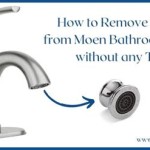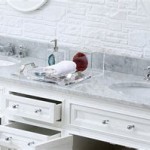How to Remove Rust Stains from Bathroom Vanities
Rust stains are a common problem in bathrooms, particularly on vanities. The combination of moisture, humidity, and the presence of iron in water can lead to the formation of these unsightly blemishes. Fortunately, with the right approach, it is possible to remove rust stains from bathroom vanities and restore their pristine appearance.
Understanding the Cause of Rust Stains
Rust stains occur when iron in water reacts with oxygen, forming iron oxide, commonly known as rust. This process is accelerated in humid environments, such as bathrooms, where water droplets and condensation provide the necessary moisture. When these water droplets containing dissolved iron come into contact with the surface of a vanity, the water evaporates, leaving behind a rust stain.
While the source of the iron may be the water supply itself, it can also come from metallic objects in the bathroom, such as faucets, pipes, or even metal accessories. The iron particles can then be transferred to the vanity surface through splashing water or direct contact.
Methods for Removing Rust Stains
Several effective methods can be employed to remove rust stains from bathroom vanities. It's crucial to choose the appropriate method based on the material of the vanity and the severity of the stain.
1. Using White Vinegar
White vinegar is an effective and eco-friendly solution for removing rust stains from many surfaces, including bathroom vanities. Its acidic nature effectively breaks down the iron oxide, dissolving the rust.
To use white vinegar, soak a cleaning cloth or paper towel in the vinegar and place it directly on the rust stain. Allow the cloth to sit for several minutes, ensuring the vinegar is in contact with the stain. Then, use a soft-bristled brush or a non-abrasive sponge to scrub the area gently. Rinse the surface thoroughly with water and dry it completely.
2. Baking Soda and Lemon Juice
Baking soda and lemon juice create a gentle yet effective paste for removing rust stains. The baking soda acts as an abrasive agent, while the lemon juice's acidity helps dissolve the rust. Combine a tablespoon of baking soda with a few drops of lemon juice to form a paste. Apply the paste directly onto the rust stain and let it sit for 15-20 minutes. Scrub the area using a soft-bristled brush or a non-abrasive sponge, then rinse with water and dry completely.
3. Using a Commercial Rust Remover
For more stubborn rust stains, a commercial rust remover may be necessary. These products contain chemicals that effectively break down rust and can be purchased at most hardware stores. Always follow the manufacturer's instructions carefully, wearing gloves and ensuring proper ventilation when using these products.
Apply the rust remover directly to the stain and allow it to sit for the recommended time. Then, scrub the area with a soft-bristled brush or a non-abrasive sponge. Rinse the surface thoroughly with water and dry it completely. Remember to test the rust remover on an inconspicuous area of the vanity first to ensure it does not damage the finish.
4. Using Steel Wool
Steel wool can be used to remove rust stains, but it should be used with caution. Steel wool is abrasive and can damage the surface of the vanity if not used carefully. It is best used on non-porous materials such as stainless steel or porcelain.
Dampen the steel wool with water and gently rub it over the rust stain in a back-and-forth motion. Be careful not to press too hard, as this can lead to scratches. Rinse the surface thoroughly with water and dry it completely. If the rust stain is particularly stubborn, you may need to use a commercial rust remover in conjunction with steel wool.
Preventing Rust Stains
While removing existing rust stains is important, preventing their formation is even more critical. Here are some tips to reduce the chance of rust stains developing on your bathroom vanity:
- Ensure proper ventilation: Adequate ventilation in the bathroom helps reduce humidity levels, minimizing the moisture that can contribute to rust formation.
- Clean up spills promptly: Spilled liquids, especially those containing iron, can lead to rust stains. Wipe up spills immediately to prevent them from drying and leaving behind stains.
- Use a water softener: Hard water, rich in minerals like iron, can contribute to rust stains. Installing a water softener can reduce the iron content in your water supply, thus minimizing the likelihood of rust stains.
- Protect your vanity: Apply a sealant to your vanity's surface, especially if it is made of natural stone. This can create a protective barrier that prevents water and iron from penetrating the surface.
By following these tips and using the appropriate methods for removing rust stains, you can maintain the pristine appearance of your bathroom vanity and prevent future rust formation.

How To Get A Clean Porcelain Sink And Remove Rust Stains Too Mom 4 Real

Simple Cleaning Trick How To Remove Rust From Chrome In The Bathroom Simplicity South

Here S How To Remove Rust Stains From Your Bathroom

How To Remove Rust Stains From Sink Tub Mr Handyman

How To Get A Clean Porcelain Sink And Remove Rust Stains Too Mom 4 Real

Simple Cleaning Trick How To Remove Rust From Chrome In The Bathroom Simplicity South

How Do I Remove Rust Stains From Cultured Marble Bathroom Sink Hometalk

How Do I Remove This Embedded Stain From Bathroom Sink Hometalk

Housekeeping Tips Removing Rust From Marble

How To Remove Rust Stains From Porcelain Sink Kitchen Infinity
Related Posts







